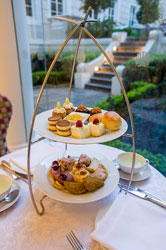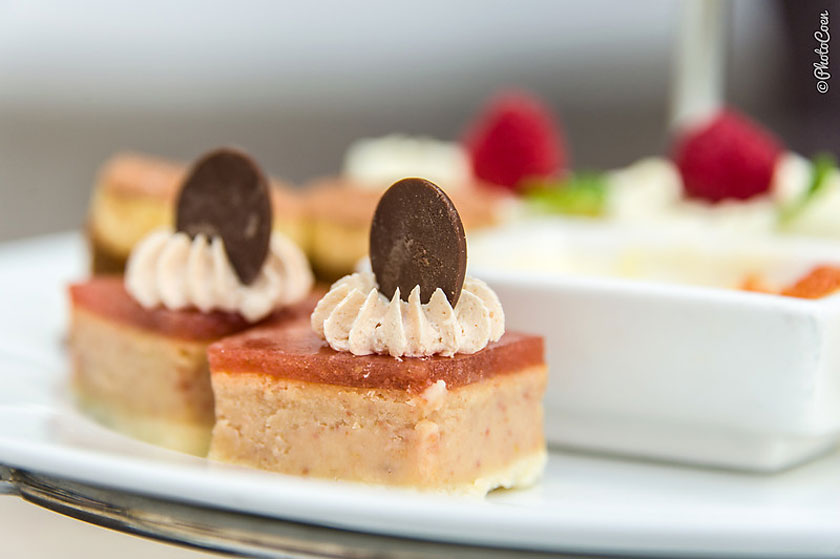Do I start with a mini cheese empanada, the all too attractive looking lemon pie, or do I slow down and just appreciate my agua de frescos, an enticing concoction of amaranth flowers and herbs (think:verbena, spearmint and lemongrass)? Although far from life-and-death decisions, these are the questions spinning around in my mind when sitting in Casa Gangotena‘s glass-roofed patio with a two-tiered silver serving tray full of local and traditional high tea nibbles. Welcome to high tea in Quito, Ecuador.
RELATED: Beach Food in Ecuador, Eat Like a Local
The Boutique Hotel of Casa Gangotena is a restored historic mansion situated along the large cobbled square of Plaza San Francisco in Quito. It has high ceilings, a rich mixture of Ecuadorian and contemporary furnishings and decorations, comforts at every turn, and a high-level of service. It’s also the perfect place to take a rest when sightseeing Quito’s old town, when your legs need a break and your stomach is calling out to be filled. Between 4 and 6 pm, Casa Gangotena serves a high tea for about $18 for two.
After hours of wandering through the pleasant chaos and cacophony that characterizes Quito’s old town streets, markets and plazas, this high tea provides a moment of tranquility. Behind the thick walls of this age-old mansion the street noise is replaced by soft music and the chatter of other visitors. [pagebreak]

Andrés Davila, Casa Gangotena’s chef de cuisine, has made it his mission to upgrade the traditionally low reputation of Ecuador’s food to a level of international cuisine. One of the results is a unique high tea, based on the traditional way of serving it in England but with Ecuadorian touches. You’ll find typically British sweet treats such as scones with butter and marmalade, as well as tidbits entirely based on local ingredients, for example turnovers made of green plantains and shrimp.
One of the key elements of Casa Gangotena’s high tea – as well as of its entire menu served in the adjacent restaurant – is the use of local ingredients. In the nearby San Roque neighborhood artesanos produce all kinds of traditional sweets and it is home to Quito’s oldest market: the San Francisco Market (1893). Here Andrés buys pretty much everything except meat and fish, for which he has other suppliers. The San Roque neighborhood even has a mill that grinds different kinds of grain into flour. [pagebreak]
When the product, or quality of a certain product can’t be found in Quito, Andrés will search elsewhere in Ecuador. He has contacts with organic vegetable farmers in Cotopaxi, the Oriente, as well as along the coast. For the same reason of quality, Casa Gangotena’s coffee for cafe molido (espresso machine) comes from the Loja region, but the coffee for the cafe de pasado (regular filter coffee) is purchased in Carche, in the north of the country.
Some ingredients for Casa Gangotena’s high tea, however, can be found right here, in the hotel’s patio garden. Victor, the waiter, took me outside to point out the herbs growing there, including mint, cedron (lemon verbena), and toronjil (lemon balm). I could take my pick so the kitchen could prepare yet another infusion for me.
With the arrival of my tea served in a pot and the two-tiered server the waiter took his time pointing out what the kitchen had prepared for me: a sandwich with thinly sliced pernil, empanadas, and a slice of quiche lorraine were among the savory bites. On the top layer was a selection of scones, banana cake, guyaba mousse, and lemon pie. Which brought me back to my original question: which was I going to try first?


![Making Mealtime Matter with La Familia: Easy Sofrito [Video]](https://thelatinkitchen.com/wp-content/uploads/2015/10/sofrito-shutterstock__0-500x383.jpg)
![Easy Latin Smoothies: Goji Berry Smoothie [Video]](https://thelatinkitchen.com/wp-content/uploads/2015/12/goji_berry-shutterstock_-500x383.jpg)
















![Fun and Fast Recipes: Fiesta Cabbage Salad [Video]](https://thelatinkitchen.com/wp-content/uploads/2015/11/fiesta_cabbage_slaw-shutterstock_-500x383.jpg)









